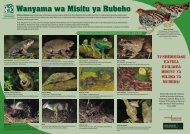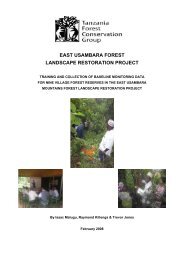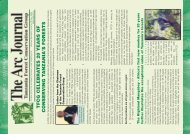Assessment of the biological values of different land cover types in ...
Assessment of the biological values of different land cover types in ...
Assessment of the biological values of different land cover types in ...
You also want an ePaper? Increase the reach of your titles
YUMPU automatically turns print PDFs into web optimized ePapers that Google loves.
4) Birds<br />
4.1 Introduction<br />
The East Usambara Mounta<strong>in</strong>s conta<strong>in</strong> six out <strong>of</strong> <strong>the</strong> 19 Eastern Arc endemic bird species and 13 out <strong>of</strong> 26<br />
near endemic species (Burgess et al., 2007). No s<strong>in</strong>gle-block endemic bird species have been reported <strong>in</strong> <strong>the</strong><br />
East Usambara Mounta<strong>in</strong>s (Baker and Baker, 2002).<br />
Birds <strong>of</strong> <strong>the</strong> Eastern Arc Mounta<strong>in</strong>s are amongst <strong>the</strong> best studied taxa, as it is <strong>the</strong> case with o<strong>the</strong>r parts <strong>of</strong> <strong>the</strong><br />
world. The East Usambara Mounta<strong>in</strong>s are one <strong>of</strong> <strong>the</strong> most studied mounta<strong>in</strong> blocks <strong>in</strong> Tanzania. However,<br />
most <strong>of</strong> <strong>the</strong> studies were conf<strong>in</strong>ed to <strong>the</strong> sites which are managed by <strong>the</strong> central government authorities.<br />
The village <strong>land</strong>scapes visited dur<strong>in</strong>g this survey are part <strong>of</strong> <strong>the</strong> East Usambara Important Bird Area (Baker<br />
and Baker, 2002).<br />
4.2 Methods<br />
Two methods were used to assess <strong>the</strong> bird fauna <strong>of</strong> <strong>the</strong> three village <strong>land</strong>scapes: Mist nett<strong>in</strong>g and Timed<br />
Species Count (TSC). The surveys were conducted <strong>in</strong> <strong>the</strong> vic<strong>in</strong>ity <strong>of</strong> <strong>the</strong> vegetation plots.<br />
4.2.1 Mist nett<strong>in</strong>g<br />
Ten nets (five 12 m long and five 10 m long) were placed <strong>in</strong> a cont<strong>in</strong>uous l<strong>in</strong>e <strong>in</strong> each <strong>of</strong> <strong>the</strong> three sites for<br />
three days. The nets were opened early <strong>in</strong> <strong>the</strong> morn<strong>in</strong>g, checked frequently throughout <strong>the</strong> day and closed at<br />
dusk. Nett<strong>in</strong>g sites were at <strong>the</strong> vic<strong>in</strong>ity <strong>of</strong> <strong>the</strong> vegetation plots <strong>in</strong> <strong>the</strong> village forest reserves.<br />
Each captured bird was identified and morphometric measurements were taken <strong>in</strong>clud<strong>in</strong>g weight, bill, tarsus,<br />
w<strong>in</strong>g and tail. Where possible, sex and age were also recorded. Each capture was marked by a marker pen on<br />
<strong>the</strong> bill, as this made it easy to recognise recaptures thus avoid<strong>in</strong>g repeat<strong>in</strong>g records <strong>of</strong> <strong>the</strong> same bird. Two bird<br />
species were recaptured <strong>in</strong> Misalai: Olive sunbird and Little Greenbul (twice).<br />
4.2.2 Timed Species Count<br />
The field team walked quietly for a period <strong>of</strong> 60 m<strong>in</strong>utes at each vegetation plot <strong>in</strong> <strong>the</strong> morn<strong>in</strong>g, stopp<strong>in</strong>g<br />
frequently to identify and record all birds seen or heard call<strong>in</strong>g. Approximately an area <strong>of</strong> 1 km 2 was <strong>cover</strong>ed at<br />
each site. Notes were recorded <strong>in</strong> a notebook <strong>in</strong> order to compile a species list.<br />
4.3 Sampl<strong>in</strong>g <strong>in</strong>tensity<br />
The bird survey work was carried out by Victor Mkongewa, a field ornithologist; <strong>in</strong> three village <strong>land</strong>scapes <strong>of</strong><br />
Misalai, Shembangeda and Kwatango. Timed Species Counts were conducted <strong>in</strong> n<strong>in</strong>e vegetation plots while<br />
mist nett<strong>in</strong>g was conducted <strong>in</strong> <strong>the</strong> vic<strong>in</strong>ity <strong>of</strong> <strong>the</strong> three vegetation plots which were established <strong>in</strong> <strong>the</strong> forests.<br />
Timed species counts were conducted <strong>in</strong> <strong>the</strong> vegetation plots with <strong>the</strong> follow<strong>in</strong>g coord<strong>in</strong>ates <strong>in</strong> Misalai between<br />
15/02 – 16/02/2009: 0459964/9446401; 0459623/9444539 and 0459039/9443745 while mist nett<strong>in</strong>g was<br />
conducted at 0458902/9445582 between 3/11 – 5/11/2008 (Table 7). All sites were situated between 958 and<br />
1212 m a.s.l. For Shambangeda <strong>land</strong>scape, TSC was conducted between 17/02 – 18/02/2009 at<br />
0458710/9440288 and 0458786/9442508 while mist nett<strong>in</strong>g was conducted at 0459231/9440838 between<br />
25/10 – 28/10/2008, altitude ranged from 887 to 971 m a.s.l. In Kwatango village <strong>land</strong>scape, TSC was carried<br />
out at altitud<strong>in</strong>al variation <strong>of</strong> 178 to 233 m a.s.l. between 19/02 – 20/02/2009 at 0470734/9446282,<br />
0470745/9447458, 0471931/9443422 and 0471310/9445254 while mist nett<strong>in</strong>g was conducted between 30/10<br />
– 01/11/2008 at 0469746/9446451.<br />
23






